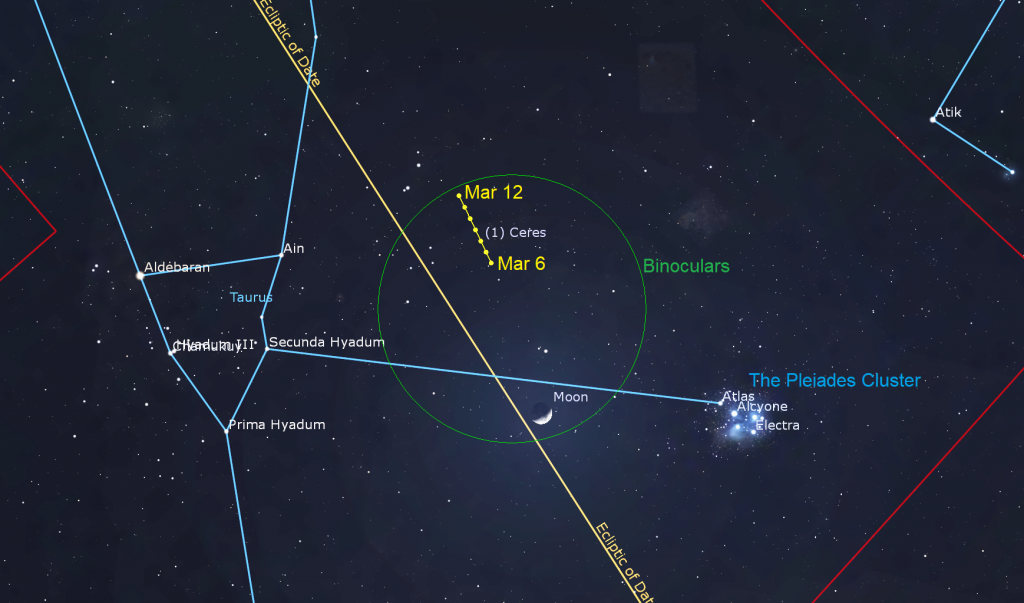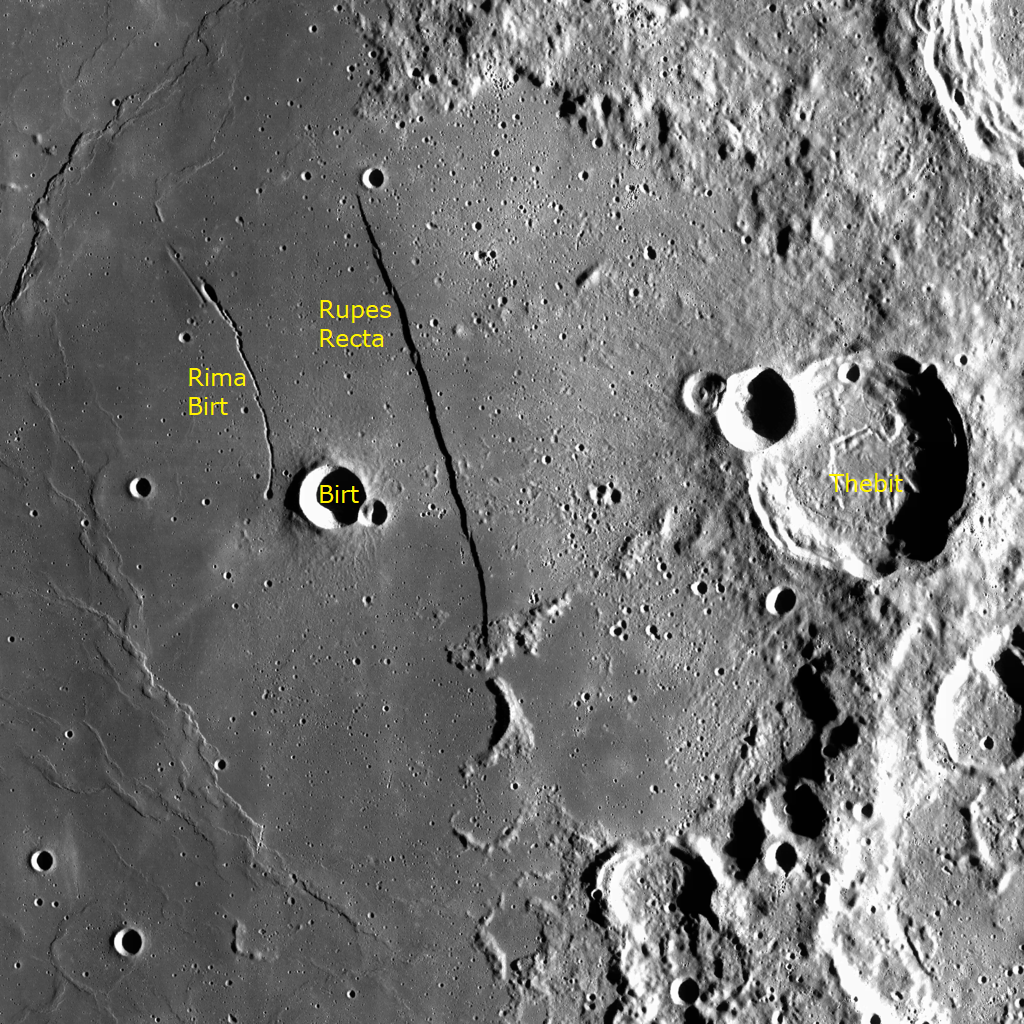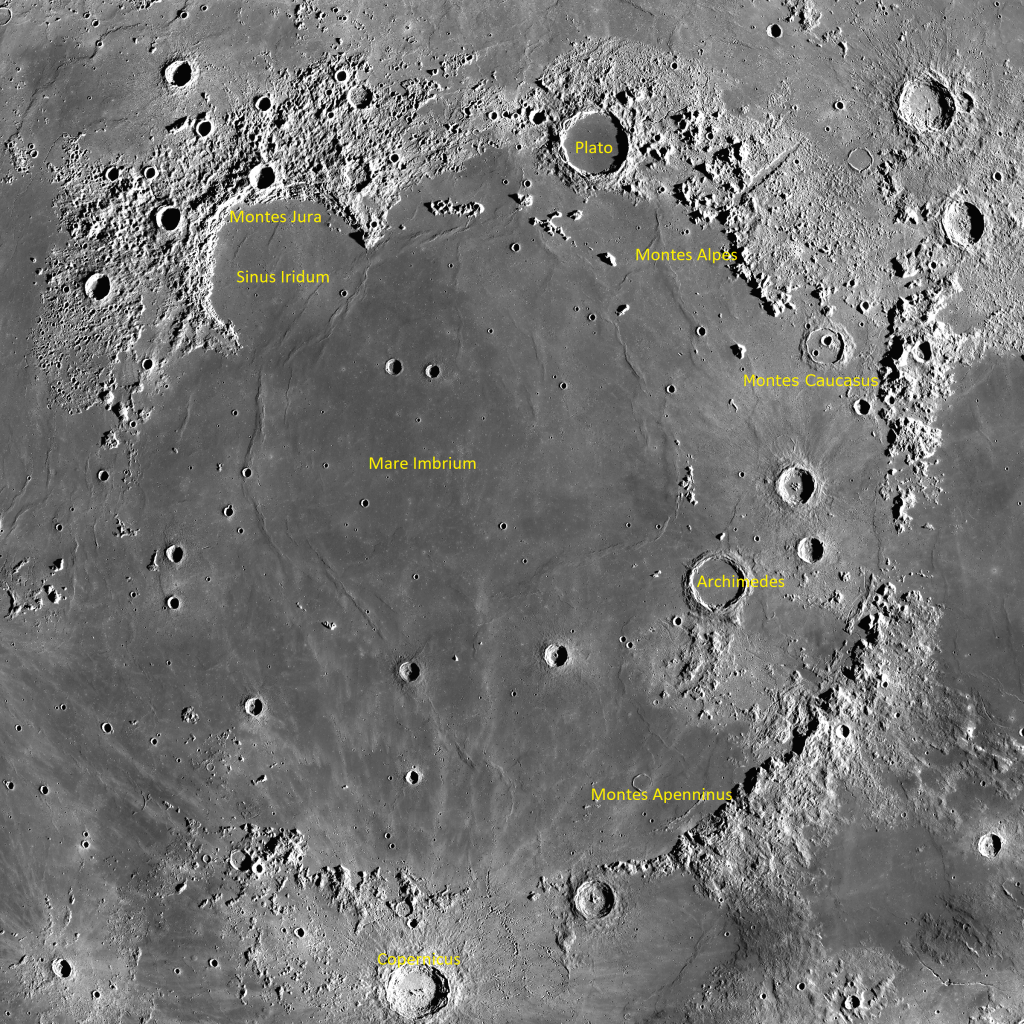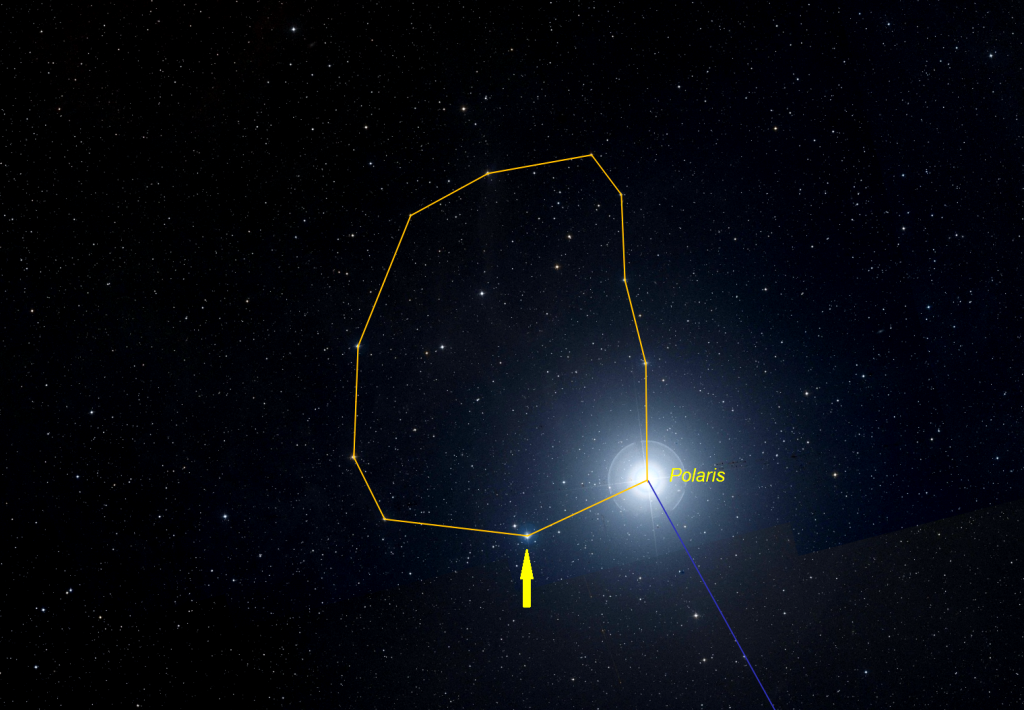The Terminator Returns, Peering at Pre-dawn Solar Neighbours, Peeking at Polaris, and Saving Daylight!

The southeastern sky, shown here at 6 am local time at the latitude of Toronto, hosts the bright planets Venus and Mars, with Saturn to the east (lower left). Before the sky brightens too much, observers can try to spot fainter main belt asteroid Vesta near Venus and Mars.
Hello, March Stargazers!
Here are your Astronomy Skylights for the week of March 6th, 2022 by Chris Vaughan. Feel free to pass this along to your friends and send me your comments, questions, and suggested topics. You can also follow me on Twitter as @astrogeoguy! Unless otherwise noted, all times are expressed in Eastern Time. To subscribe to these emails please click this MailChimp link.
If you’d like me to bring my Digital Starlab portable inflatable planetarium to your school or other daytime or evening event, or deliver a session online, contact me through AstroGeo.ca, and we’ll tour the Universe, or the Earth’s interior, together! My terrific new book with John A. Read entitled 110 Things to See With a Telescope is a guide to viewing the deep sky objects in the Messier List – for both beginners and seasoned astronomers. DM me to order a signed copy!
The waxing moon will shine prettily in the evening sky worldwide this week, with only Uranus and the dwarf planet Ceres for company. Meanwhile, Venus and Mars, plus last-to-rise Saturn, will share the southeastern sky before dawn. I also share some insights on Daylight Saving Time, and the Pole star, Polaris. Read on for your Skylights!
Daylight Saving Time
For jurisdictions that employ Daylight Saving Time (or DST, for short), clocks should be set forward by one hour at 2 am local time on Sunday, March 13 – or before you go to sleep on Saturday night. In North America the “Spring Forward” will remain in effect until Daylight Saving Time reverts to Standard Time when we “Fall Back” on November 6, 2022.
For most of human history people woke with the sun and went to bed at dusk. At equatorial latitudes, where most people lived, hunted, and farmed, the number of hours of daylight through the year didn’t vary too much – so that approach worked well. But, as communities spread around the world and began to use standardize working hours – especially at latitudes farther from the equator where the days lengthened and shortened dramatically throughout the year – people were forced to use artificial light indoors when the sun wasn’t shining into windows.
Scientist/naturalist Benjamin Franklin, in a satire he published while living in Paris in 1784, proposed that Parisians get out of bed earlier to take advantage of the early sunrises in summer – and thereby save money on candles and oil in evening. For the same reason, during the 19th Century it became common for schools and businesses to adjust their operating hours with the seasons – but that practice wasn’t standardized.

New Zealand entomologist George Hudson first proposed what became Daylight Saving Time in 1895 – but he wanted the clocks to shift by 2 hours! The idea then spread to England where prominent English builder and outdoorsman William Willett, who was also an avid golfer, noted that more work (and golf) could be fit into the day if the clocks were advanced during the warm months. While the British parliament toyed with the proposal for years, it was Canada that led the way on Daylight Saving Time!
The first city in the world to enact DST, on July 1, 1908, was Port Arthur, Ontario, Canada – followed soon after by Orillia, Ontario. The German Empire and Austria-Hungary adopted DST on April 30, 1916 as a way to conserve coal during World War I. Britain and most of its allies, plus many European neutrals soon followed. The USA adopted DST in 1918. Except for Canada, the UK, France, Ireland, and the United States, DST was abandoned after the war; but it was re-instated during World War II and then widely adopted as a result of the energy crisis of the 1970’s.
The inconvenience of twice-yearly clock changes has led to calls to abandon the practice. Some jurisdictions, including Ontario, Canada, are proposing to remain on DST year-round. I’d prefer to remain on Standard Time. For stargazers, advancing clocks by one hour, plus the fact that sunset occurs 1 minute later with each passing day near the March equinox, means that spring and summer star parties and dark-sky observing cannot begin until much later in the evening – usually after the bedtime of junior astronomers! Staying on DST will also mean that existing sundials will be permanently wrong because solar noon will occur at 1 pm, and not at 12 pm.
The names and abbreviations for time zones change when DST is in effect. Eastern Standard Time (EST) becomes Eastern Daylight Time (EDT) – and so on. For those who deal with the timing of astronomical events, the difference between your local time and the international standard of Greenwich Mean Time (or GMT), and the astronomers’ Universal Time (UT), is reduced by one hour when DST is in effect.
One final thought. If your time zone is broad, covering many degrees of longitude, then, despite sharing the same time on the clock, the sunrise and sunset times can be radically different for locations on the eastern and western edges of the zone. The Eastern Time zone covers nearly two hours’ worth of longitude at the latitudes of Ontario and Quebec! If you want your summer sunsets to occur at the latest possible time, live in the western part of your time zone. If you prefer more daylight in the early morning, live as far to the east in your zone as possible. Trevor at Plateau Astro explained it very well on YouTube here.
The Moon
This is the best week of the lunar month for viewing the moon. For everyone on Earth (except the southern polar region), the moon will be shining prettily in the western sky after sunset. On each consecutive evening, the waxing moon will fill with light as it increases its angle from the sun – by about 11° per day. The terminator, the pole-to-pole line that divides the lit hemisphere from the dark hemisphere, will march steadily westward on the moon. As it does so, the terminator’s shape will vary from a deep curve tonight (Sunday) to a straight line at mid-week. Then it will bend the other way as the moon becomes increasingly gibbous. Astronomers of old deduced that the moon was spherical by the way the terminator bent over time.
The terminator encircles the entire moon. Someone standing anywhere along the Earth-facing lunar terminator will experience sunrise, while their counterpart on the lunar far side will see the sun setting. The Earth’s terminator sweeps past us at every sunrise and sunset. At the equator, it travels at a whopping 1670 km per hour! At the latitude of the Great Lakes (about 43°) that speed is reduced to 1220 km per hour. (You multiply 1670 by the cosine of your latitude.) Since the tidally locked moon only rotates on its axis once per month, its terminator sweeps past astronauts at a mere 9.6 km per hour!

The sunlight arriving along the terminator is nearly horizontal, producing severe shadows to the lunar west of every bump, ridge, mountain, and crater rim. With no atmosphere on the moon to scatter light, the edges of those shadows are sharp, producing spectacular vistas in binoculars and any sized telescope. In as little as a few hours you can note differences in the way features are lit and shadowed. Watch craters fill with light, led off by their central peaks. During a romantic date on Earth, you can pause your dinner to watch the sun set. It only takes a few minutes. On the moon, the restaurants have no atmosphere, and the sun takes hours to rise or set. No atmosphere means you’ll see no red sunset glow either!
Tonight (Sunday) the slim crescent moon will rise in the daytime and then catch your eye in the southwestern sky once the sun has set. It too, will set around 10:30 pm in your time zone. Tonight’s waxing crescent moon will be located in southern Aries (the Ram), a short distance below (or celestial west) of the magnitude 6.8 planet Uranus. By the time Uranus sets in late evening, the moon’s orbital motion will have carried it closer to the planet, especially for observers in the western Americas. Observers in parts of eastern Antarctica, southeastern Australia, southeastern Melanesia, and southwestern Polynesia can watch the moon cross in front of (or occult) Uranus in the period around 07:30 Greenwich Mean Time.

The moon will set about an hour later each night. On Tuesday evening, its nearly half-illuminated crescent will be traveling through the stars of Taurus (the Bull). The prominent Pleiades star cluster will be positioned several finger widths to the moon’s right (celestial northwest) and the bright, orange star Aldebaran will be shining a fist’s diameter to the moon’s upper left. To better see the Pleiades’ stars, keep the moon beyond the left side of your binoculars’ field of view. Over several hours, the orbital motion of the moon will lift it higher compared to the surrounding stars and also towards the magnitude 8.8 minor planet Ceres. During a period around 08:45 GMT on Wednesday, March 9, observers in western and northern Australia, eastern Indonesia, Papua New Guinea, northern Melanesia, Micronesia, and northern Polynesia (except Hawaii) can see the moon occult Ceres.
Our natural night-light will officially reach its first quarter phase on Thursday morning at 5:45 am EST (or 10:45 GMT). But it won’t be visible in the Americas at that time – moon phases occur independently of Earth’s rotation. That morning timing means that the moon will look close to half-illuminated, on its eastern side, on both Wednesday and Thursday evening, while shining between the horn stars of Taurus.

The moon will visit Gemini (the Twins) on Friday and Saturday night. By that time its greater angle from the sun will cause it to set during the wee hours of the night. On those two evenings, the terminator will fall just to the left (or lunar west) of Rupes Recta, also known as the Lunar Straight Wall. The rupes, Latin for “cliff”, is a north-south aligned fault scarp that extends for 110 km across the southeastern part of Mare Nubium. That’s the dark patch sitting in the lower third of the moon’s Earth-facing hemisphere. The wall, which is very easy to see in good binoculars and backyard telescopes, is located above the very bright crater Tycho.

Thursday to Saturday will be an excellent time to view the three impressive, curved mountain chains that encircle the eastern rim of dark Mare Imbrium. That giant impact basin, covering much of the north-central portion of the moon’s Earth-facing hemisphere, will be partly in light and partly in shadow. Those mountains, actually segments of the old crater rim, will be starkly illuminated by slanted sunlight.
The most northerly arc of mountains is the Lunar Alps, or Montes Alpes. Their peaks reach up to 2400 metres above the moon’s average surface. Use binoculars or a telescope to look for a gash cutting through them called the Alpine Valley, or Vallis Alpes. It’s a rift valley, up to 10 km wide, where the moon’s crust has dropped due to faulting. To the lower right (lunar southeast) of the Alps are the Caucasus Mountains, or Montes Caucasus. This stubby, but high (up to 6000 metres tall) mountain range disappears under a lava-flooded zone connecting Mare Imbrium with Mare Serenitatis. The mountains resume along the southeastern edge of Mare Imbrium as the lengthy Apennine Mountains, or Montes Apenninus. They, too, peter out near the prominent crater Eratosthenes, and the larger crater Copernicus beyond it. The Apennines have several large peaks reaching 5000 metres high.

The Copernicus region will be lit by sunshine From Saturday onwards.
The Planets
If you have clear skies toward the southeast and an unobstructed view in that direction, consider a trip outside before sunrise to see the pretty pairing of Venus and Mars this week. Extremely bright Venus will rise first, at about 4:30 am local time and stay visible in the lower part of the sky almost until sunrise. Unlike airplanes, Venus won’t blink or flash, or move around. By about 5:30 am, the 250 times fainter dot of reddish Mars will appear to Venus’ lower right (celestial south). Mars will disappear in the brightening sky before very long, so take your look at it before about 6 am local time. In a telescope Venus will exhibit a nearly half-illuminated, waxing crescent phase. (Good binoculars will also reveal Venus’ shape.) Mars will show a tiny disk. (Be sure to turn all optics away from the eastern horizon before the sun rises.)

For another week or so, Venus and Mars will be travelling eastward on gradually converging, parallel tracks. At the same time they will be slowly increasing their angle from the sun, and rising earlier. The large asteroid designated (4) Vesta, which is visible in binoculars and backyard telescopes, will be located several finger widths to the upper right (west) of Venus and Mars – increasing that gap as their faster orbital motion leaves it behind. By the end of this week, Vesta will be too far from the two planets to share the view in binoculars with them.

The yellowish dot of Saturn will spend March breaking free of the predawn glow as it slowly pulls away from the sun. This week, it will rise by 5:45 am local time, but it will be extremely low in the east-southeast. Its general location will be 1.8 fist diameters to the lower left of Venus-Mars (or 18 degrees to the celestial east). Observers near latitudes of Florida, Hawaii, Mumbai, and farther south will spot Saturn more easily. Watch for Mercury sitting below it.
Uranus is the only planet remaining in the evening sky – but its viewing window is closing. Once the sky fully darkens, towards 8 pm local time, the magnitude +5.8 planet will be visible in binoculars and backyard telescopes – even with your unaided eyes on dark, clear nights, if you know where to look. The planet’s small, blue-green dot will be positioned a fist’s width to the left of (or 11 degrees to the celestial southeast of) Aries’ brightest stars, Hamal and Sheratan. In fact, it’s almost exactly midway along a line connecting Hamal with the bright star Menkar in Cetus (the Whale). At 8 pm local time, those stars will sit a third of the way up the west-southwestern sky. By 9 pm local time, Uranus will be too low for decent views.
Pointing at Polaris
Polaris, commonly known as the North Star, sits at the tip of the curved handle of the Little Dipper asterism. The seven stars in the Little Dipper also form the constellation Ursa Minor (the Little Bear). Polaris’ astronomical names include Alpha Ursae Minoris, 1 UMi, and HD 8890, HIP 11767, HR 424. Early astronomers assigned Greek letters to the brightest stars in a constellation, using alpha for the brightest and so on. Those latter codes are from the star catalogues named for astronomers Johann Bayer and Henry Draper, the Hipparchus space telescope, and the Harvard Revised Photometry Catalogue.
Contrary to popular opinion, Polaris is not a prominent star at all. It is a much larger star than our sun, and it emits 2500 times more light. Its surface temperature is similar to our sun’s. Since Polaris is located about 430 light-years from Earth, it shines at magnitude 1.95, ranking it only 48th in brightness.
Polaris’ fame is due to its steadfast position over the northern horizon, and its utility for navigation on Earth before the advent of GPS. While the rest of the sky revolves due to Earth’s rotation, Polaris remains anchored in place because it sits less than a finger’s width from the North Celestial Pole (or NCP, for short), the imaginary point in space that the Earth’s axis of rotation points toward. Due to precession, the slow wobble of the Earth’s axis, Polaris will slowly drift even closer to the NCP until the year 2101. The star Thuban in Draco (the Dragon) was the pole star when the pyramids were built. Between about 4000 and 7000 AD, several of the stars in Cepheus (the King) will take turns as Earth’s pole star, although none of those will mark it as precisely as Polaris does.

Recognizing Polaris’ unique position in the heavens, other world cultures have named it accordingly. Medieval Islamic astronomers called it Mismar, meaning “needle” or “nail,” al-kaukab al-shamaliyy “the north star,” and al-kutb al-shamaliyy “the northern axle (or spindle).” The Inuit call Polaris Nuutuittuq or Niqirtsuituq meaning “never moves”. The star is depicted on the flag and coat of arms of the Canadian Inuit territory of Nunavut, as well as on the flag of the U.S. state of Alaska. In traditional Lakota star knowledge, Polaris is named Wičháȟpi owáŋžila “the Star that Sits Still”.
You can measure your latitude on Earth by measuring how many degrees above the horizon Polaris is. A clenched fist held at arm’s length covers ten degrees of the sky. Count the number of fist diameters between the horizon and Polaris. Combine that knowledge with the fact that the point on the horizon directly below Polaris marks geographic north, and you’re well on your way to figuring out your location on Earth – at least, that’s what folks did before GPS! (Don’t forget that compasses measure magnetic north, which can be different from geographic north.)
Polaris can easily be seen with your unaided eyes in a moderately dark sky. If you don’t already know your latitude and the direction of north, the easiest way to find Polaris is by using two stars in the Big Dipper’s bowl. During evening in March the dipper is standing upright on its handle in the northeastern sky. Join an imaginary line from Merak (the bottom of the bowl) to Dubhe (“DOO-bee”, at the rim of the bowl) and keep going. The next obvious star will be Polaris. It’s about three fist diameters away from Dubhe. Don’t forget that the Big Dipper, like everything else in the sky, circles around Polaris continuously. During some parts of the year you’ll be drawing that line upwards, and at other times toward the left or the right. Merak and Dubhe are often referred to as the Pointers.

In early-March at around 8 pm local time, the Little Dipper pattern curves down and to the right from Polaris. Continuing that arc upwards to the right will lead you towards the Big Dipper. The two dippers fall on either side of the tail stars of Draco (the Dragon). The magnitude 2.06 star at the outer edge of the Little Dipper’s bowl (and closest to the Big Dipper) is named Kochab. This K-class, reddish star is slightly fainter than Polaris. The other five stars of Ursa Minor may be too dim to see from the city with unaided eyes, but binoculars will reveal them.
If you have a telescope, aim it at Polaris and look for a tiny, white star named HIP 7283 that sits close to yellow-tinted Polaris. As before, the rotation of the sky can place that little star anywhere on a circle surrounding Polaris. On early-March evenings, it will be to Polaris’ lower left, but your telescope’s optics will probably flip and/or mirror that orientation. You can connect that little star with a number of other stars to form a small, roughly circular ring of stars a finger’s width across. It’s on the side of Polaris opposite to Kochab. It’s called the Engagement Ring, and Polaris is the diamond. Let me know if you see it!
Follow the Winter Milky Way
In case you missed it, I posted last week’s tour of the winter Milky Way here.
Public Astro-Themed Events
Every Monday evening, York University’s Allan I. Carswell Observatory runs an online star party – broadcasting views from four telescopes/cameras, answering viewer questions, and taking requests! Details are here. Their in-person Wednesday night viewing has been converted to online via the observatory YouTube channel.
On Wednesday evening, March 9 at 7:30 pm EST, Join Space Place Event Committee Chair Julie Tomé on a free exclusive tour of the Allan I. Carswell Observatory at York University, with guests current Observatory Director Dr. Elaina Hyde, former Observatory Director Paul Delaney, and members of the all-student staff. Evenbrite registration and details are here.
Public sessions at the David Dunlap Observatory may not be running at the moment, but RASC are pleased to offer some virtual experiences instead in partnership with Richmond Hill. The modest fee supports RASC’s education and public outreach efforts at DDO.
On Friday night, March 11 from 8 to 9:30 pm EDT, the DDO Astronomy Speakers Night program will feature Dr. Elaina Hyde, director of York University’s Allan I. Carswell Observatory. She’ll speak on Telescope Spaceship: An Observatory Journey. There will also be a virtual tour of the DDO and live-streamed views from the DDO’s 74-Inch telescope (weather permitting). Only one registration per household is required. Deadline to register for this program is Wednesday March 9, 2022 at 3 pm. More information is here and the registration link is here.
On Sunday afternoon, March 13 from 1 to 2 pm EDT, join me for Ask an Astronomer. During these family-friendly sessions, I’ll answer your questions about the universe and review what’s up nowadays. Only one registration per household is required. Deadline to register for this program is Wednesday, March 9, 2021 at 3 pm. Prior to the start of the program, registrants will be emailed the virtual program links. The registration link is here.
My free, family-friendly Insider’s Guide to the Galaxy webcasts with Samantha Jewett of RASC National returns on Tuesday, March 15 at 3:30 pm EST, when we’ll broadcast live from Canada’s largest optical telescope at the David Dunlap Observatory, taking about the DDO and large telescopes. And – we’ll continue with our Messier Objects observing certificate program. You can find more details and the schedule of future sessions here.
Don’t forget to take advantage of the astronomy-themed YouTube videos posted by RASC Toronto Centre and RASC Canada.
Keep looking up, and enjoy the sky when you do. I love questions and requests. Send me some!